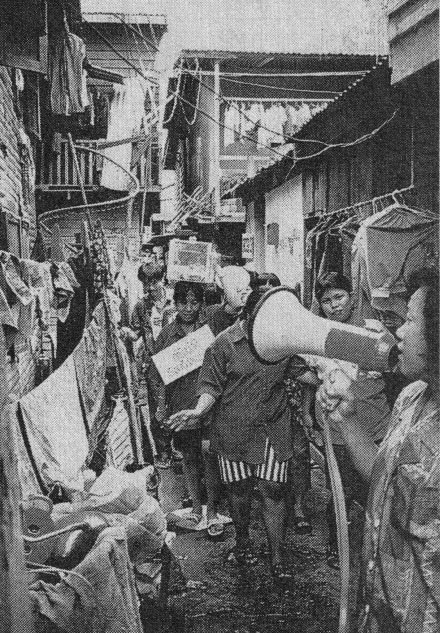Thailand Donations from the SlumsJanuary 1993

“This is a mere token of our Namchai (feelings),” modestly said the people who live in the slum of Khlongtoey, Bangkok. They sent donation to the victims of the Great Hanshin Earthquake. I was moved by their generosities. This January, one year after the earthquake, visited them in the slum (its population is about 30,000).
阪神淡路大震災から1年

At the sight of the inferno televised even in Thailand at that time, a welfare worker, Prateap Unsontum Hata (42), set her mind on collecting donations. The children studying on a Japanese scholarship took the lead in collecting donations. They went around the alleys with a donation box. The donations amounted to 1,200,000 baht (one baht is about four yen). Prateep Unsontum Shin brought the money to Kobe in person at the beginning of February.
Swanna (24), a restaurant employee, who was decorating the alley where a party would be held on New Year’s Eve, said shyly, “If someone is in difficulties, we have to help each other. The rich or the poor, it doesn’t matter.” Chanya (45), a Thai noodle shop owner, said, “I felt a kind of sympathy. I felt as if it were my own affair.” Maya (11), who helps her father with the work of collecting waste materials, donated three baht, saying “My teacher said I would become clever if I did somebody good.””
Although we couldn’t do much, the embassy staff came to thank us. I felt embarrassed,” Prateep said in a modest way, and she added, “I wish no more disaster, but I hope that more Thais and Japanese will experience these feelings and be “brothers” who can understand the feelings of each other.
The income of the people living in slums, who are supporting the rapidly growing Thai economy at the bottom of the society, is sometimes less than 145 baht a day that is prescribed by the Minimum Wage Act. I asked them why they donated what little money they had in spite of not being well off at all. “To help people out of difficulties means to strive after virtue to Thai people,” said Shirimar (42), doing homework of sewing with a machine under a shelf with a family Buddhist altar. Pishit, a bike-taxi rider who threads through a traffic jam in Bangkok said, “I donated so that I could go to heaven.” Though he is still 17 years old, he believes retribution.
The donations from those people were handed to the groups that did a volunteer job in the stricken area and used to hold the events to comfort the children who lost their parents or houses and to set up temporary day nurseries.
The people of Khlongtoey slum live out their lives happily, making nothing of the bad working conditions and living surroundings. Not only me but also many people must have heard their yell of enthusiastic encouragement through the donations.
But this time, in the slum I met with a horrible incident that reminded me of the wretched spectacle in Nagata Ward of Kobe City. At night of December 30th, a big fire broke out. Everything in the area of 8,000? was burnt to ashes and thousands of people were burnt out of home. In the early morning of New Year’s Day, mendicant monks came to the area which escaped being stricken, asking for alms as usual. I saw Thai Namchai in the manner of people who were giving alms and praying with their hands pressed together.
